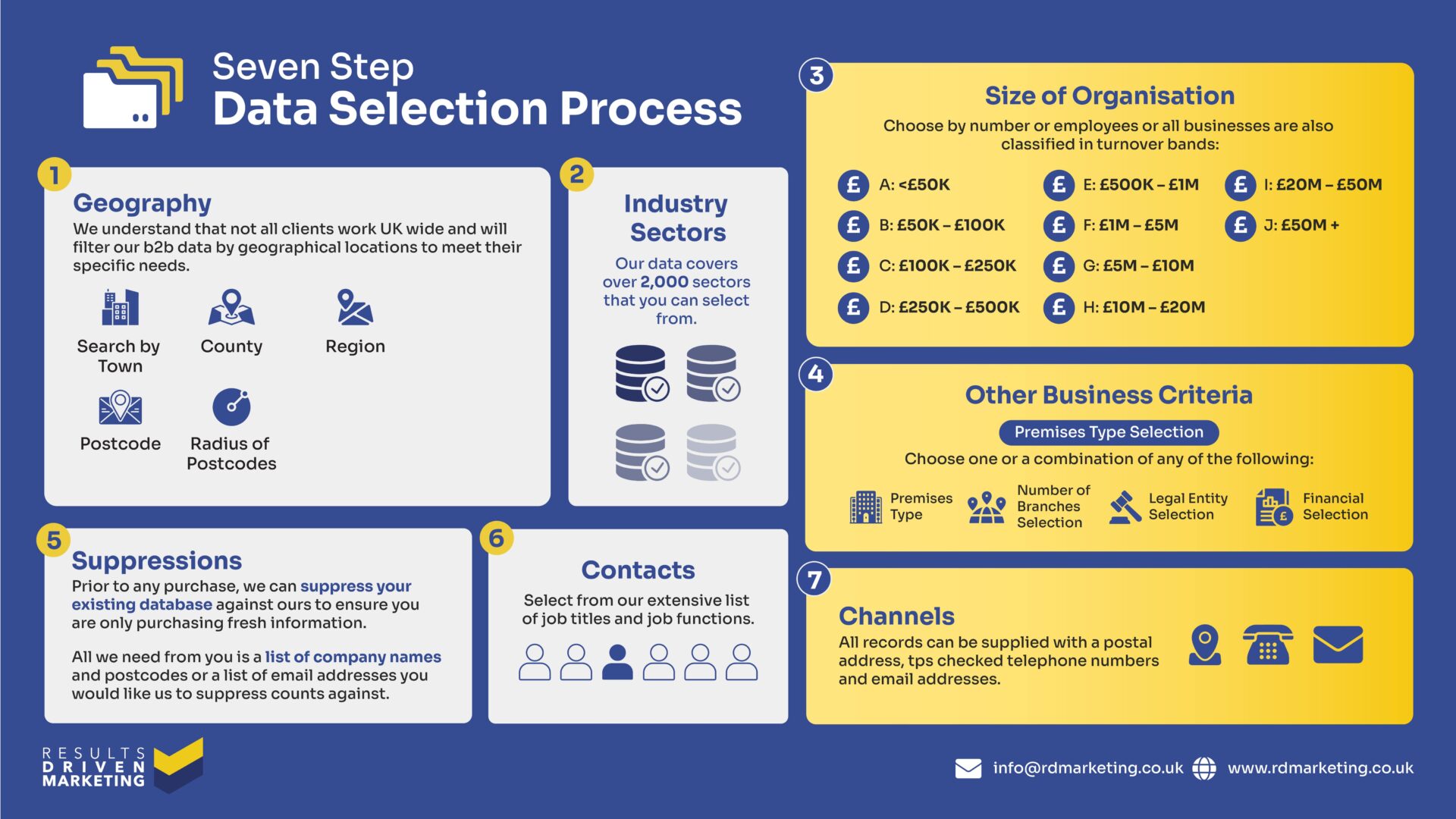
What Is The Mailing Preference Service?
The Mailing Preference Service is a free service available to UK residents, designed to help you reduce the amount of unsolicited direct mail you receive. By registering with MPS, you can take control of what arrives at your door, ultimately leading to less clutter and greater peace of mind.
But why is the Postal Preference Service so important? The sheer volume of junk mail not only invades your privacy but also poses environmental concerns. Moreover, with data privacy becoming a hot topic, it’s crucial to understand how services like MPS can protect your personal information from being misused. This article will break down everything you need to know about the Postal Preference Service—what it is, how it works, and why it’s a valuable tool in today’s data-driven world.
And if your business relies on direct mail, we also offer Direct Mail Data to ensure your marketing efforts are targeted and compliant.
Stay with us as we delve into the details of how you can take control of your mailbox and protect your privacy through the Postal Preference Service.
Table of contents:
What is the Mailing Preference Service?
The Postal Preference Service is a valuable tool for anyone looking to take control of the amount of unsolicited mail they receive. Essentially, the Postal Preference Service is a free service that allows UK residents to opt out of receiving unwanted direct mail from companies. This service is particularly useful for those who find themselves inundated with marketing materials and advertisements that they never signed up for.
So, where did the Mailing Preference Service come from? The MPS was established by the Direct Marketing Association (DMA) in the UK, a body dedicated to promoting responsible and ethical marketing practices.
For businesses that rely on direct mail as part of their marketing strategy, understanding the Postal Preference Service is crucial. It’s not just about compliance; it’s about ensuring that your marketing efforts are directed toward those who are genuinely interested. If your business needs to reach the right audience, you might want to explore our Direct Mail Data services to make sure your campaigns are as effective as possible.
The Mailing Preference Service is a win-win for both consumers and businesses. Consumers get to reduce the amount of unwanted mail they receive, while businesses can avoid wasting resources on uninterested recipients. If you’re involved in telemarketing, the same principles apply. Make sure to check out our Telemarketing Data services to help you reach the right audience efficiently.
The Postal Preference Service is not just about stopping mail; it’s about giving individuals control over their privacy and helping businesses target their efforts more effectively. Understanding and using the Postal Preference Service can make a significant difference in how both consumers and businesses manage direct mail communication.
How Does the Postal Preference Service Work?
So, how exactly does the Mailing Preference Service (MPS) work? It’s simpler than you might think, and it’s a great way to reduce the amount of unsolicited mail that clutters up your mailbox. Let’s break it down step by step.
Registering with the Mailing Preference Service
The first step is to register your details with the Mailing Preference Service. This can be done online through the official MPS website. When you sign up, you’ll be asked to provide your name and address—the very details that companies use to send you direct mail.
Once you’ve filled out the registration form, your details will be added to the MPS database. This list is then made available to companies that send out direct mail, so they know who not to contact. It’s important to note that the Mailing Preference Service is completely free, so there’s no cost involved in signing up.
What Types of Mail Does MPS Cover?
The Mailing Preference Service primarily covers addressed mail—this is the kind of mail that has your name and address on it, typically sent by companies for marketing purposes. By registering with MPS, you’re telling these companies that you don’t want to receive this type of mail.
However, it’s worth noting that the MPS doesn’t cover all types of mail. For example, unaddressed mail—like leaflets or flyers delivered to “The Occupier”—is not covered by the Mailing Preference Service. You might still receive these types of mailings even after registering with MPS. Additionally, mail from organisations you have an existing relationship with, like your bank or insurance company, might still come through unless you tell them directly to stop.
If your business relies on targeted mail campaigns, it’s crucial to ensure you’re reaching the right audience. Consider using our Email Address List Data service to help refine your marketing efforts and avoid sending unwanted mail.
Understanding the Registration Process and Duration
After you’ve registered with the POstal Preference Service, your request is processed, and your details are added to the database. The process typically takes around two to three months to become fully effective. During this time, companies will gradually update their mailing lists to exclude your details.
Once you’re registered, your details will remain on the MPS list for a period of five years. After this time, you’ll need to renew your registration if you want to continue benefiting from the service.
The Cost and Availability of the Service
One of the great things about the Postal Preference Service is that it’s completely free for individuals. There are no hidden charges or fees, so you can easily reduce your direct mail without worrying about costs.
For businesses, understanding the implications of the Postal Preference Service is essential for maintaining ethical marketing practices. If you’re looking to clean up your mailing lists and ensure compliance, our Data Cleansing Services can be an invaluable resource.
In summary, the Postal Preference Service is an effective way to manage the amount of unsolicited mail you receive, and it’s easy to get started. By following these simple steps, you can take control of your mailbox and enjoy a clutter-free home.
How to use the Postal Preference Service (MPS) — quick, practical guide
Whether you’re cutting down junk mail at home or keeping a campaign compliant, the Postal Preference Service is simple to put into practice. Use this checklist to get it right the first time.
For individuals (2-minute setup)
-
Register with the Postal Preference Service using your full name and address.
-
Allow 8–12 weeks for mailers to refresh their lists (you may still see some addressed mail in the meantime).
-
Stop unaddressed mail separately (door-to-door “The Occupier” items aren’t covered by MPS) via local Royal Mail opt-out.
-
Renew every 5 years or when you move home so the Postal Preference Service continues to apply to your new address.
-
Tell brands directly if you’ve had a relationship with them — MPS doesn’t override existing customer consents.
For businesses (reduce waste & stay compliant)
-
Screen before you send
-
Suppress all MPS-registered addresses from your direct mail.
-
Keep a dated audit trail of suppression runs.
-
-
Separate addressed vs. unaddressed
-
The Postal Preference Service covers addressed mail. Manage “door drop” activity with separate controls and local opt-outs.
-
-
Respect preferences across channels
-
Pair MPS with TPS/CTPS for phone and internal suppression lists for email.
-
-
Refresh regularly
-
Re-run MPS suppression before each new drop (don’t rely on last quarter’s file).
-
-
Be transparent
-
State why someone received mail and how to opt out. Clear opt-outs reduce complaints and returns.
-
Common pitfalls to avoid
-
Assuming MPS is instant — it takes a few weeks for full effect.
-
Ignoring legacy lists — old files need re-screening against the Postal Preference Service.
-
Treating MPS as optional — it’s a core part of ethical, compliant direct mail.
How Results Driven Marketing can help
-
Direct Mail Data: Pre-screened files with MPS suppression applied to reduce waste.
-
Data Cleansing Services: De-duplication, address hygiene, and recurring MPS/TPS/CTPS processing.
-
Email & Telemarketing Support: Cohesive suppression strategy across all channels.
Bottom line: used correctly, the Postal Preference Service cuts clutter for households and boosts relevance for businesses — fewer returns, lower print/postage waste, and better brand trust.
Benefits of Using the Postal Preference Service
Using the Mailing Preference Service (MPS) comes with a range of benefits, both for individuals and businesses. Whether you’re tired of sifting through piles of junk mail or you’re a business looking to refine your marketing strategy, the Postal Preference Service offers valuable advantages that are worth considering.
Benefits for Individuals
Reduce Junk Mail: The most immediate benefit of registering with the Postal Preference Service is the significant reduction in unsolicited mail that ends up in your mailbox. By opting out of receiving direct mail from companies you have no relationship with, you can keep your home free from unwanted clutter.
Protect Personal Information: In today’s digital age, protecting your personal information is more critical than ever. The Mailing Preference Service helps safeguard your privacy by preventing companies from sending you direct mail based on your personal data. This not only reduces the chances of your information being mishandled but also limits the exposure of your data to third-party marketers.
Environmental Impact: Registering with the Postal Preference Service also has a positive impact on the environment. By reducing the amount of direct mail sent to your home, you’re helping to decrease the overall demand for paper, printing, and transportation, all of which contribute to environmental degradation. It’s a small step that can lead to significant ecological benefits.
Peace of Mind: Let’s face it—less junk mail means less stress. When you’re not constantly bombarded with unwanted offers and advertisements, you can focus on the things that truly matter. The Mailing Preference Service gives you more control over what enters your home, leading to a more organised and peaceful living space.
If you’re looking to manage your business data effectively, consider using our Data Enrichment Services to ensure your information is up-to-date and accurate.
Benefits for Businesses
Improved Targeting: For businesses, the Mailing Preference Service offers a way to refine your marketing efforts. By excluding those who have opted out of receiving direct mail, you can focus your resources on reaching an audience that is more likely to be interested in your products or services. This not only increases the effectiveness of your campaigns but also improves your return on investment (ROI).
Compliance with Regulations: In a world where data privacy regulations are becoming increasingly stringent, adhering to the Mailing Preference Service guidelines ensures that your business remains compliant. Avoiding the penalties associated with non-compliance can save your company from potential legal issues and financial losses. Additionally, using services like our CTPS Checker can further enhance your compliance efforts.
Enhanced Customer Trust: Respecting customer preferences by adhering to the Mailing Preference Service not only aligns with ethical marketing practices but also builds trust with your audience. Customers are more likely to engage with businesses that respect their privacy and communication preferences. This trust can translate into stronger customer relationships and long-term loyalty.
Cost Efficiency: By utilising the Mailing Preference Service, businesses can avoid wasting resources on individuals who have no interest in their products. This leads to more cost-effective campaigns, where every marketing pound is spent wisely. If you’re targeting international markets, our International Email List can help you reach the right audience without unnecessary waste.
Supporting Statistics
Research has shown that the Postal Preference Service is effective in significantly reducing the amount of unwanted mail received by individuals. According to a study by the Direct Marketing Association, individuals who register with the MPS experience up to a 95% reduction in unsolicited direct mail. This not only highlights the efficiency of the service but also underscores its value for both consumers and businesses alike.
In conclusion, the Postal Preference Service is a powerful tool for managing direct mail, offering a range of benefits that make it an essential service in today’s data-driven world. Whether you’re an individual seeking to reduce clutter and protect your privacy or a business aiming to enhance your marketing efforts, MPS can make a significant difference. And if your business needs accurate and reliable data, our B2B Data services can provide the foundation you need for successful campaigns.
Using the Postal Preference Service to Improve Direct Mail Campaigns
For businesses, the Postal Preference Service isn’t just about consumer choice — it’s a strategic tool that can improve the effectiveness of direct mail marketing. By respecting the MPS and integrating it into your campaigns, you avoid wasted costs, stay compliant, and build trust with your audience.
Why Screening Against the Postal Preference Service Matters
Mailing to people who have registered with the Postal Preference Service damages both ROI and reputation. By screening your lists before every drop, you ensure:
-
Cost savings — fewer wasted prints and postage.
-
Higher engagement rates — because you’re only contacting people open to receiving mail.
-
Legal compliance — reduced risk of complaints or breaches of marketing standards.
At RD Marketing, our Direct Mail Data comes pre-screened against the Postal Preference Service, so you can launch campaigns with confidence.
Combining PPS With B2B Data Services
The real value comes when you pair suppression files with accurate B2B marketing data. For example:
-
Use Data Cleansing Services to remove duplicates and old addresses.
-
Apply Data Enrichment Services to add missing details like industry sector or job role.
-
Supplement with Telemarketing Data and Email Address List Data for multi-channel outreach that complements your direct mail.
By combining the Postal Preference Service with fresh, targeted data, you create campaigns that are both compliant and highly effective.
Building Trust Through Compliance
When prospects see that you’ve respected their communication preferences, they’re more likely to view your brand positively. This credibility is vital in competitive markets, where trust can be the deciding factor in securing new business.
Common Misconceptions About the Postal Preference Service
When it comes to the Mailing Preference Service (MPS), there are quite a few misconceptions floating around. It’s not uncommon for people to misunderstand what the Postal Preference Service can and can’t do, leading to unrealistic expectations or even skepticism about its effectiveness. Let’s clear up some of the most common myths and set the record straight.
The Mailing Preference Service Stops All Mail
One of the biggest misconceptions about the Mailing Preference Service is the belief that registering with MPS will stop all mail from arriving at your doorstep. While it’s true that MPS can significantly reduce the amount of unsolicited direct mail you receive, it doesn’t stop everything. The Mailing Preference Service is specifically designed to block addressed direct mail from companies you have no prior relationship with.
However, there are exceptions. For example, unaddressed mail—like flyers or leaflets that are delivered to every home in an area—won’t be stopped by the MPS. Additionally, mail from organisations you’ve interacted with before, such as banks, insurance companies, or charities you’ve supported, can still be sent to you unless you specifically opt out with those organisations directly.
For businesses, it’s crucial to understand these limitations when planning your marketing strategies. If you’re targeting a broad audience, consider our Consumer Data services to ensure your message reaches the right people.
The Mailing Preference Service Is a Scam
Another common myth is that the Postal Preference Service is some kind of scam, designed to collect your personal information for marketing purposes. This couldn’t be further from the truth. The Mailing Preference Service is a legitimate service operated by the Direct Marketing Association (DMA) in the UK. It exists to help consumers take control of the direct mail they receive and is regulated to ensure your information is protected.
When you register with the MPS, your details are securely stored and only shared with companies for the sole purpose of removing you from their mailing lists. It’s a straightforward service with no hidden agenda. Plus, it’s completely free to use, so there’s no risk involved in signing up.
For companies, respecting the Mailing Preference Service guidelines is not just about compliance; it’s about building trust with your audience. Ensuring your data is clean and up-to-date is crucial, and our Data Cleansing Services can help you achieve that.
The Postal Preference Service Works Instantly
Many people assume that once they register with the Postal Preference Service, the unwanted mail will stop arriving immediately. Unfortunately, that’s not the case. While the Mailing Preference Service is effective, it does take some time for the process to kick in. Typically, it can take up to three months for your registration to be fully implemented, as companies update their mailing lists on a regular schedule.
During this period, you might still receive some unsolicited mail, but rest assured, the volume will decrease significantly over time. It’s also important to remember that your MPS registration lasts for five years, after which you’ll need to renew to continue benefiting from the service.
If you’re a business aiming to refine your marketing strategy, consider leveraging our B2B Data to better target your audience while respecting their preferences.
In summary, while the Mailing Preference Service is a powerful tool for reducing unwanted direct mail, it’s important to understand its limitations and how it actually works. By setting realistic expectations, both consumers and businesses can make the most of this valuable service.
How to Register for the Mailing Preference Service
If you’ve decided that the Postal Preference Service is right for you, registering is a straightforward process. In just a few simple steps, you can start reducing the amount of unsolicited mail that lands in your mailbox. Let’s walk through how to sign up for the Mailing Preference Service and ensure your details are properly updated when necessary.
Visit the Mailing Preference Service Website
To begin, go to the official Postal Preference Service website. Once there, you’ll find a clear option to register. Click on the registration link to start the process. It’s helpful to have your personal information ready, such as your full name and home address, as these details will be required to complete your registration.
Fill Out the Registration Form
The next step involves filling out the online registration form. This form will ask for your name, address, and contact details. It’s important to enter your information accurately to ensure that the Postal Preference Service can effectively block unsolicited mail. If you’re unsure about any of the fields, the website often provides helpful tips and guidance along the way.
After you’ve entered all your details, review the form to make sure everything is correct. Once you’re satisfied, submit the form. At this point, your information will be added to the MPS database, which is used by companies to remove your address from their mailing lists.
For businesses looking to ensure their data is accurate before conducting direct mail campaigns, consider using our Data Cleansing Services. This service can help you maintain a clean and up-to-date mailing list, ensuring compliance with the Mailing Preference Service.
Confirm Your Registration
After submitting the form, you may receive a confirmation email or letter from the Postal Preference Service. This confirmation serves as proof that your registration was successful. It’s a good idea to keep this confirmation in case you need to refer to it later.
Updating or Renewing Your Registration
Your registration with the Mailing Preference Service is valid for five years. After this period, you’ll need to renew your registration to continue benefiting from the service. To renew, simply follow the same steps as when you initially registered. It’s a quick and easy process that ensures you remain protected from unsolicited mail.
If you move to a new address, it’s essential to update your details with the MPS. You can do this by revisiting the website and following the instructions for updating your information. Keeping your details current ensures that the Mailing Preference Service continues to work effectively for you.
For businesses interested in reaching the right audience, our Telemarketing Data services can help target your campaigns more effectively, ensuring compliance with the MPS and maximising your marketing efforts.
Enjoy a Clutter-Free Mailbox
Once your registration is active, you can expect to see a noticeable reduction in the amount of unsolicited mail you receive within a few months. The Postal Preference Service takes about two to three months to fully take effect, as companies update their mailing lists accordingly.
By following these simple steps, you can take control of your mailbox and enjoy a more organised and clutter-free home. And if you’re a business seeking to optimise your marketing strategies, don’t forget to explore our range of services, from B2B Data to Email Marketing Management, to help you reach the right audience with precision and compliance.
Alternatives to the Postal Preference Service
While the Mailing Preference Service (MPS) is an effective way to reduce unsolicited mail, it’s not the only option available. There are other methods and services that can help you cut down on the unwanted marketing materials that end up in your mailbox.
Contacting Companies Directly
One of the most straightforward alternatives to the Postal Preference Service is to contact companies directly. If you’re receiving mail from specific businesses that you no longer wish to hear from, you can reach out to them and request to be removed from their mailing lists. Most companies are required by law to honor these requests, making this a quick and effective way to reduce unwanted mail.
Opting Out of Specific Marketing Lists
Another approach is to opt out of specific marketing lists. Many companies provide an option to unsubscribe from their mailings, either through a form on their website or by contacting their customer service. By doing so, you can tailor the types of communications you receive, ensuring that you only get mail that’s relevant to you.
For businesses looking to refine their marketing efforts, our Direct Mail Data services can help ensure that your campaigns are reaching the right audience, minimising waste and improving effectiveness.
Other Preference Services
In addition to the Mailing Preference Service, there are other preference services designed to help you manage different types of unsolicited communications:
- Telephone Preference Service (TPS): If you’re tired of receiving unsolicited phone calls, the Telephone Preference Service allows you to opt out of marketing calls. Once registered, your number will be added to a database that telemarketers are required to check before making calls.
- Email Preference Service (EPS): Similar to MPS and TPS, the Email Preference Service helps you reduce unwanted marketing emails. By registering with EPS, you can limit the number of promotional emails that land in your inbox.
These preference services, alongside the Mailing Preference Service, offer a comprehensive approach to managing your personal communications. If you’re a business aiming to respect these preferences while still reaching your target audience, our Email Address List Data can help you create more targeted and effective email campaigns.
In conclusion, while the Mailing Preference Service is a powerful tool for managing direct mail, exploring these alternatives can further enhance your control over unwanted communications, giving you peace of mind and a more organised mailbox.
The Role of the Mailing Preference Service in Data Protection and Privacy
In an age where personal data is increasingly valuable, the Mailing Preference Service (MPS) plays a crucial role in protecting privacy and ensuring data is handled responsibly. By allowing individuals to opt out of unsolicited direct mail, the Mailing Preference Service contributes significantly to data protection and aligns with broader privacy regulations like the GDPR (General Data Protection Regulation).
Protecting Personal Information
One of the primary functions of the Mailing Preference Service is to safeguard personal information. When you register with MPS, your name and address are added to a database that companies must consult before sending direct mail. This prevents your personal details from being freely circulated among marketers, reducing the risk of your information being misused or sold to third parties. Essentially, the Mailing Preference Service acts as a gatekeeper, ensuring that your data isn’t exploited for unwanted marketing purposes.
For businesses, understanding the importance of data protection is essential. Using accurate and compliant data sources, such as our B2B Data, ensures that your marketing efforts are not only effective but also respect the privacy of your audience.
GDPR and Other Data Protection Regulations
The relevance of the Mailing Preference Service has only grown with the advent of stricter data protection laws, particularly the GDPR. The GDPR, which applies across the European Union and the UK, sets out rigorous requirements for how personal data should be collected, processed, and stored. Non-compliance can lead to significant fines and reputational damage.
The Mailing Preference Service helps businesses comply with these regulations by providing a clear, legally recognised method for managing consumer consent. By ensuring that your mailing lists are cross-checked against the MPS database, you’re actively adhering to GDPR guidelines and protecting your business from potential legal pitfalls.
For companies looking to ensure compliance across various communication channels, services like our CTPS Checker can further support your efforts in maintaining GDPR compliance.
Aligning with Ethical Marketing Practices
Beyond legal compliance, the Mailing Preference Service aligns with the principles of ethical marketing. Ethical marketing is about respecting consumer choices and fostering trust between businesses and their customers. By honoring the preferences expressed through MPS, companies demonstrate a commitment to responsible marketing practices that prioritise consumer autonomy and data privacy.
To further enhance your ethical marketing strategies, consider leveraging our Data Enrichment Services. These services can help you better understand your audience and tailor your communications in a way that respects their preferences while still achieving your marketing goals.
In summary, the Mailing Preference Service is more than just a tool for reducing junk mail—it’s a key player in the broader landscape of data protection and privacy. By integrating MPS into your data management practices, you’re not only protecting consumers but also positioning your business as a leader in ethical and compliant marketing.
In summary, the Mailing Preference Service (MPS) is a powerful tool for anyone looking to reduce the amount of unsolicited mail they receive while also protecting their personal information. By registering with MPS, you can take control of your mailbox, contribute to environmental conservation, and ensure that your privacy is respected.
We have also….
We’ve covered how the Mailing Preference Service works, its benefits for both individuals and businesses, and the common misconceptions that surround it. We also explored how MPS plays a vital role in data protection and aligns with ethical marketing practices. Whether you’re an individual looking to declutter your home or a business aiming to comply with GDPR and other data regulations, the Mailing Preference Service offers significant advantages.
If you haven’t yet registered with the MPS, now is the perfect time to take that step toward a more organised and private mailbox. And if you’re a business, understanding and respecting the Mailing Preference Service can enhance your marketing efforts while building trust with your audience.
Who are we?
Dedicated to lead generation, Results Driven Marketing provides myriad services SMEs can trust to deliver results.
Our marketing lists are guaranteed accurate to industry high standards, and GDPR compliant and our experience team means that if you are looking to buy data, they make them totally bespoke and highly relevant whether you are looking for email lists, direct mailing lists or telemarketing lists.
Our email marketing software is highly rated. Responder provides the automation tools you need to put your marketing on autopilot.
We also supply email marketing solutions with our email marketing platform.
Call us today on 0191 406 6399 to discuss your specific needs.
Results Driven Marketing
info@rdmarketing.co.uk
0191 406 6399









